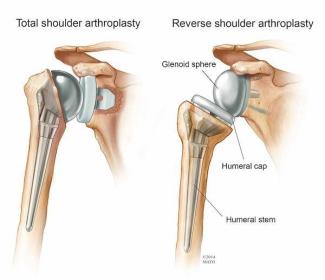
What to Expect After Shoulder Replacement
A total shoulder arthroplasty (or total shoulder replacement) is a common surgical procedure performed for individuals with shoulder joint dysfunction. The shoulder complex, which consists of the clavicle, scapula and humerus, is the most mobile joint in the body. Due to being a more mobile and less stable joint it is more susceptible to instability, injury or dysfunction. Indications for shoulder replacement are arthritis, decreased blood flow leading to dying of bone (avascular necrosis), damage due to rheumatoid arthritis or traumatic injury. Shoulder replacement typically provides patients with improvements in pain, range of motion and overall function.
Shoulder replacement surgery can be broken down into two main types- traditional total shoulder replacement or reverse total shoulder replacement. A traditional replacement maintains the original anatomical configuration (ball and socket) of the joint. The damaged ball is replaced is a metal ball and stem that put into the upper arm bone (humerus). The socket (glenoid) is resurfaced for increased joint mobility. Conversely, a reverse total shoulder replacement is exactly the opposite- the ball and socket are reversed. Typically, patients with a deficient rotator cuff receive a reverse replacement due to the rotator cuff’s inability to stabilize the joint.
Following shoulder replacement surgery, the patient will utilize a sling for approximately 4-6 weeks. This is done to allow the surgical repair and soft tissues to heal properly. The goal of the first phase of rehab is to control pain and inflammation, begin to introduce passive motion (your physical therapist moving your arm) to the shoulder and allow healing to occur. Because the patient will be in the sling continuously each day, they are instructed to avoid all active motion (moving the arm themselves). Patients are also instructed to perform active motion of the elbow, wrist and hand to avoid stiffening of the joints.
After 4-6 weeks, your physical therapist will begin to progress range of motion exercises and prescribe you with a home exercise program. Here you will begin activating the muscles of the shoulder girdle by performing isometrics, or simply turning the muscles(s) on. Here you will also begin actively moving the arm yourself. Exercises to strengthen the scapular muscles will also be initiated.
Beginning around 6 weeks, depending on your progress, you will begin resisted exercises for the shoulder joint with light bands. From this point you and your physical therapist will progressively progress ROM and strengthening exercises as you gradually build tolerance. For those that are more active, patients can typically return to activities such as gardening, golf or other sports around 4-6 months. Timetables and return to activities/sport are different for every individual and will be discussed with your physical therapist.
If you are suffering from shoulder pain and/or dysfunction that is affecting your ability to perform daily tasks, please contact your primary care provider or physical therapist. For additional information, please contact your local Doctor of Physical Therapy for an assessment and recommendations. Remember, physical therapists improve the way you move!
Ryan Hastie, PT, DPT, CSCS
Doctor of Physical Therapy
Certified Strength and Conditioning Specialist
Titleist Performance Institute Medical 2 Certified

